New Products & Services
September 2014

The newly released Centum VP R5.04 is an enhanced version of this company’s flagship integrated production control system. This new Centum release features enhanced alarm and batch functions. With the Centum system, a prominently colored tag mark is displayed on the HMI screen next to any measurement reading that falls outside the normal range. With Centum VP R5.04, these colored tag marks now come in a variety of easily recognizable shapes that indicate the importance of a measurement item and the severity of an anomaly (critical, high-risk, medium-risk, low-risk and so on). New audible alarms have also been added to provide information on the severity and equipment location of an anomaly. Through the use of color, shape and sound, operators can quickly and intuitively recognize the significance of a specific alarm, thereby allowing for improved operational safety. — Yokogawa Corp. of America, Newnan, Ga.
www.yokogawa.com/usFrom September 30 to October 2, more than 700 exhibitors from over 25 countries will again be coming to the Nuremberg exhibition center to attend Powtech, one of the world’s leading trade fair in its field, showing everything the chemical process industries (CPI) needs to handle powders, granulates and bulk materials — including analysis. What follows is a small sample of some of the new products that will be on display during the exhibition.
One principle, many possibilities with this mixer
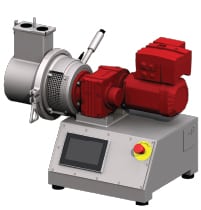
This company is demonstrating the versatile application of its horizontal Ploughshare mixer. Both a batch mixer, FKM, and a continuous mixer, KM, are on display. Both machines are available with drum volumes of between 130 and 30,000 L. The company is also presenting the Type N 5 laboratory mixer (photo). With a drum volume of 5 L, the Type N 5 laboratory mixer is available for product and process development, as well as for small-scale production. All mixers operate by the special mixing principle of the mechanically generated fluidized bed developed by the company. The so-called Ploughshare paddles rotate close to the wall of a horizontal cylindrical drum, lifting the mixing components from the drum walls and hurling them from the material bed into the open mixing chamber. The complete product is constantly drawn into the mixing process, ensuring maximum mixing intensity. Hall 5, Stand 222 — Gebr. Lödige Maschinenbau GmbH, Paderborn, Germany
www.loedige.de
Preventive fire protection for safer production
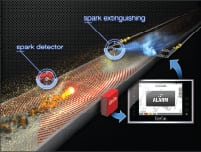 |
|
Fagus-GreCon Greten
|
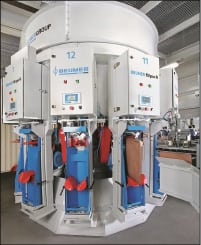
This bagging system ensures accurate filling
The fillpac bagging system (photo) can be incorporated flexibly into existing packaging lines. It is equipped with a calibratable scale. The electronic weighing unit ensures that the fillpac always achieves accurate filling quantities. Special software enables the weigher to communicate continuously with the filling spouts. This enables users to get the best out of their packaging lines, as it is not necessary to reject bags with incorrect weights from the process. Hall 1, Stand 135 — Beumer Group GmbH & Co. KG, Beckum, Germany
www.beumergroup.com
The advantages of flameless venting
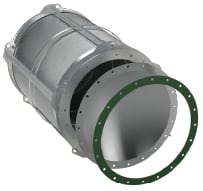 |
|
Rembe
|
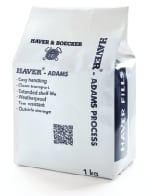
This machine enables filling compact bags for the first time
The new Roto-Packer for small bags (photo) is based on the company’s Adams technology, and fills powder-type bulk products into compact polyethylene (PE) bags for the first time. The packer achieves a rate of up to 600 bags per hour and features a stepless bag-weight selection of 1–10 kg. Filling into bags made from a film tube or pre-made bags is now possible. Using an additional module, the user may also form the bag from a flat film within the Roto-Packer system. The bags are sealed air-tight and are impermeable to the weather. They are clean, compact and provide for an attractive appearance. The user saves costs in packaging and storage, says the company. Hall 1, Stand 533 — Haver & Boecker OHG, Oelde, Germany
www.haverboecker.com
Determine concentration and particle size with this unit
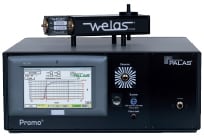
Promo (photo) is an aerosol spectrometer for analyzing both particle size (200 nm to 100 µm) and determining concentration (<1 – 106 particles/cm3). All data are displayed on a large touchscreen, and can be analyzed in realtime. Promo has a standard interface and can be controlled by a process-control system or by a simple Labview program, which makes the device suitable for control and monitoring applications. The optical fiber technology enables measurements at locations that are difficult to reach and in hazardous areas. Using fiber-optic cables, the welas sensors can easily be connected to the Promo and exchanged at will. These sensors allow measurements at temperatures between 90 and 470°C and at a pressure range from 300 mbar to 10 bars. Hall 5, Stand 156 — Palas GmbH, Karlsruhe, Germany
www.palas.de
Tableting with continuous inline weighing
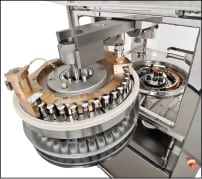 |
|
Romaco Group
|
These blowers are very energy efficient
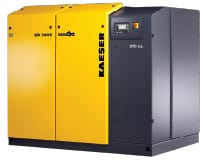 |
|
Kaeser
|
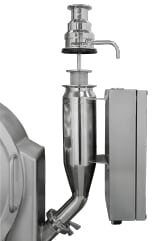 |
|
Frewitt Fabrique des machines
|
A dedusting filter module for milling machines
The new, patent-pending ProFi-Clean (photo) is a compact de-dusting and filtering device with an automatic blow-back system. The stand-alone dedusting filter can easily be retrofitted to existing sieve mills, and allows the filtering and separation of powder particles in the extracted air. The de-dusting filter is cleaned automatically by pressure impulses. This guarantees that the whole cartridge surface area remains clog-free and the powder is blown-back into the product. The pneumatic control system is built on the filter housing, therefore the filter device works completely independently. The stand-alone de-dusting filter is easily integrated into existing and new process plants. Hall 1, Stand 442 — Frewitt Fabrique des machines SA, Granges-Paccot, Switzerland
www.frewitt.chThis dryer increases the capacity of spray dryers
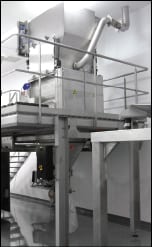 |
|
Dinnissen
|
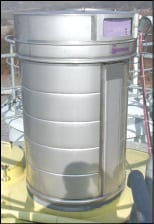 |
|
Waiweldai Anlagentechnik
|
Silo filters for all sectors of the CPI
The Sirius silo filter (photo) has a large diameter, enabling filtration surface areas from 3 to 34.4 m2. Filter housings are made of stainless steel (1.4301/304). The system is said to be maintenance-friendly, requiring only one person to perform maintenance. These filters are especially suited for silos and containers that are filled pneumatically with bulk material. Due to the stainless-steel design, the filters can be used in all industries ranging from the construction sector to the pharmaceutical industry. Hall 4, Stand 239 — Waiweldai Anlagentechnik GmbH, Grünsfeld, Germany
www.waiweldai.de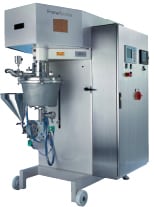
Perform superfine grinding with this ball mill
The CoBall-Mill annular gap bead mill (photo) is an in-line milling system for manufacturing suspensions and other products of almost any viscosity. This mill is the ideal solution for superfine grinding of active pharmaceutical ingredients, such as sterile ophthalmic medications and ointments, as well as numerous cosmetics and chemical applications. The unusually narrow milling chamber is filled between 50 and 80% full of beads made from wear-resistant ceramic materials. The CoBall-Mill boasts a high milling power in relation to its very small chamber and the grinding energy input can be as much as 8 kW/dm3. Users profit from extremely homogeneous results with particle sizes on the nanoscale. Thanks to the distinctive conical geometry of the rotor-stator tool, the mill inputs the milling forces directly into the product. The residence time in the milling chamber — and hence the production process overall — is therefore significantly reduced. Hall 6, Stand 357 — FrymaKoruma GmbH, Neuenburg, Germany
www.frymakoruma.com |
|
UWT
|
This capacitance level switch handles many applications
The RFnivo 3000 (photo, p. 32I-6) is a new capacitive level switch for bulk solids and is used as overfill protection, as well as a demand or empty detector in process or storage containers. The device is a single-rod probe that has been designed to detect bulk solid materials without the use of temperature-limiting components. The RFnivo is available in stainless steel grade 1.4301 (303) to 1.4404 (316L), with PPS or ceramic insulators and optional Teflon seals. While the RFnivo with ceramic insulators can cope with extreme process temperatures up to 500°C, the standard version with PPS insulators can handle temperatures up to 240°C. The RFnivo is suitable for use in containers with overpressure of up to 25 bars as standard. The electronics guarantee a very high sensitivity when used with the correlating length of a single-rod probe. Bulk materials with a dielectric value of 1.5 and more can be detected, which covers most bulk materials. Hall 4A, Stand 123 — UWT GmbH, Betzigau, Germany
www.uwt.de
Integrated solutions for process containment
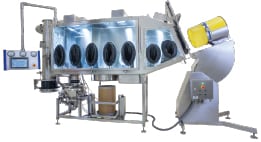
The new Isocharge system (photo) is a low-cost method of both dispensing and charging bags into reactors or receiving systems via the Powder Transfer System (PTS). The Isocharge combines the advantages of isolation and laminar flow technology, providing high containment of < 1μg/m3 per 8 h TWA (time weighted average). The station’s chamber is open to the side allowing easy bag introduction. A simple door only needs to be closed during WIP (wash in place) to prevent splashes. All WIP fluids can be drained from the chamber via the PTS into the reactor, which also cleans the transfer hose and the PTS. The Isocharge will be showcased in combination with the Continuous Liner filling system, equipped with a Dosivalve for accurate filling. Hall 1, Stand 213 — DEC Dietrich Engineering Consultants SA, Ecublens, Switzerland
www.dec-group.netThis analyzer quickly measures particle parameters
The new Analysette 28 ImageSizer is suitable for the analysis of particle shape and size of dry, free-flowing powders and bulk solids in a measuring range from 20 µm to 20 mm. Via the optical analysis of particle shape and particle size, damaged particles, contaminants, agglomerates and oversized or undersized particles are identified accurately and quickly and can be viewed as single images. At the same time, the instrument delivers a fast and efficient particle-size measurement. The measuring time (depending on the sample quantity) is under 5 min, and the result is available immediately. The analyzer is said to be ideal for easy quality control and a fast alternative to sieving. Hall 5, Stand 362 Fritsch GmbH, Idar-Oberstein, Germany
www.fritsch.de